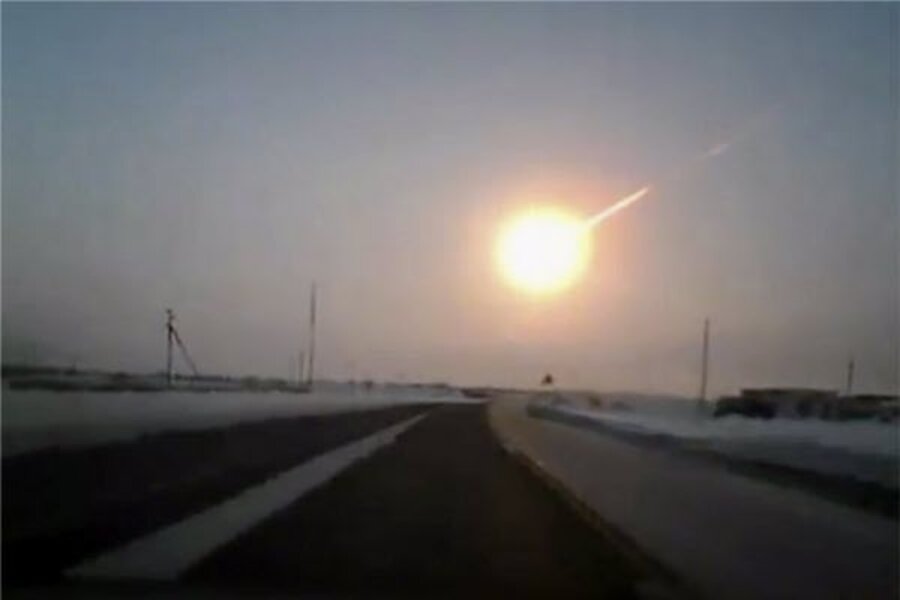Meteorites reveal the secrets of last month's Russian fireball
| THE WOODLANDS, Texas
Scientists studying small pieces of the meteor that exploded over the Russian city of Chelyabinsk on Feb. 15 are working to glean new insights into the rare impact by a space rock.
Based on the meteorite analysis, researchers have determined that last month's meteor explosion in Russia — which scientists call a superbolide — produced a shock wave that reached the ground. That shock shattered windows and injured some 1,500 people due to flying glass.
The blast also created a shower of stony meteorites that fell to Earth in an impact region more than 60 miles (100 kilometers) long.
Thinly sliced meteorites
Some of the Chelyabinsk meteorite samples have made their way to planetary scientist Larry Taylor, director of the Planetary Geosciences Institute at the University of Tennessee in Knoxville, who obtained the superbolide samples with the help of Russian colleagues.
"I got three pieces that were completely coated with black fusion crust. The total of them is less than 10 grams," Taylor told SPACE.com here at the 44th Lunar and Planetary Science Conference.
Initially, the meteorite specimens were polished and thinly sliced for a detailed inspection under a petrographic microscope. The device is a type of optical microscope used in petrology and optical mineralogy that scientists are employing to identify rocks and minerals within the thin meteorite slices.
The small samples will undergo further scrutiny over the next few months, Taylor said.
"We've just started to skim the top of it," he added.
Tapping into superbolide secrets
Taylor and his associates are now deciding the best tactics to further reveal what stories the specimens have to tell.
"The magnitude of the explosion led a whole lot of us to believe that it must have been a very volatile-rich meteor that was coming in … because it exploded so vigorously," Taylor said. Volatile materials are those that evaporate easily. “In fact, everything we found so far points to an ordinary chondrite."
About 90 percent of stony meteorites are classified as ordinary chondrites, space rocks that are lacking in volatile materials.
"It is ordinary because it's common," Taylor said. "But it is special because it contains such a wide array of things … a whole menagerie of things all in one."
Fallout from Chelyabinsk
For Taylor, studying extraterrestrial samples here on Earth is a long-time passion. He was in the "backroom" at NASA Johnson Space Center during the Apollo 17 mission in 1972, where he served one of the scientists directly advising the astronauts on their various moonwalks. Taylor is accustomed to analyzing the mineralogy, petrology and geochemistry of rocks from "out there."
"It's like every time we went to the moon, we learned something new," he said. "We could put together the story. And that's the same thing here … It's always like that."
Taylor said he suspects that the superbolide over Russia may have originally been a quite large, unusual object before it broke apart. The three pieces he is now studying were recovered in three different locations. While they are all pretty much the same in composition overall, each one has some unique characteristics, he said.
The fallout from the Chelyabinsk event may well have an impact beyond science, Taylor said.
"To see the pictures and see the devastation that this did was immense," Taylor said. "It brought back the whole fear of near-Earth asteroids. This scares the world, and I think NASA will change its priorities a bit."
Leonard David has been reporting on the space industry for more than five decades. He is former director of research for the National Commission on Space and a past editor-in-chief of the National Space Society's Ad Astra and Space World magazines. He has written for SPACE.com since 1999. Follow us @Spacedotcom, Facebook or Google+. Original article on SPACE.com.
- Huge Russian Meteor Blast is Biggest Since 1908 (Infographic)
- 5 Amazing Fireballs Caught on Video
- NEOs: Near Earth Objects - The Video Show
Copyright 2013 SPACE.com, a TechMediaNetwork company. All rights reserved. This material may not be published, broadcast, rewritten or redistributed.





